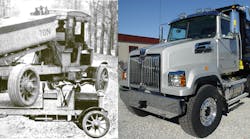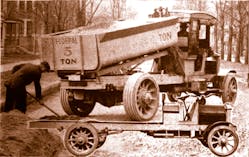How long has fluid power, as we know it, been around? I have not found a definitive answer after researching this topic many times in my career. One of the best sources on the history of fluid power is a book by John Pippenger (one of the founders of the Fluid Power Society), Fluid Power: The Hidden Giant. Another good one, which covers all the way back to ancient times, is Hydraulic Fluid Power—A Historical Timeline, by Steve Skinner. Both are available from Amazon.com.
More recently, a question was posed to me by Paul Michael, research chemist at the Milwaukee School of Engineering. Most of the people I deal with at MSOE (especially at the Fluid Power Institute) are experts in their field, and I tend to think of them as knowing everything about fluid power. But they’re human, so they can’t know everything. When Paul emailed me to ask what information I had on the early history of modern hydraulics, I was delighted to finally be able to assist him in return for the many times he and his colleagues have helped me.
I’ve gone through Pippenger’s book, and I remember reading about hydraulics used for moving gun turrets in a battleship in the early 20th Century. But that seems to have been one isolated application. In fact, further study indicates that many of the advancements were somewhat isolated.
For example, shown here is a shot from the Feb. 16, 1917 issue of The Contractor. The caption simply reads, “Five-ton truck with hydraulic dump body.” The article containing the photo provides no details about the hydraulic system. Instead, it describes the truck’s drive train and how the vehicle, loaded with 20,000 lb of sand, successfully completed a trip from Detroit to Pittsburgh.
Was the use of hydraulics for a dump bed an isolated application? Not in my opinion. It’s hard to believe that each development was an isolated incident. If that were the case, each application would’ve been a reinvention of the wheel. Instead, inventors probably knew of previous applications of hydraulics and adapted or improved them to suit their application.
It wouldn’t be until about another 30 years that these early developers had a forum to share what they learned. That forum was Applied Hydraulics magazine, the original title of Hydraulics & Pneumatics. Applied Hydraulics served as a conduit for industry leaders to eventually form the National Fluid Power Association, which hosted the National Conference on Fluid Power. We know that event today as the IFPE Technical Conference, held every three years in conjunction with IFPE and ConExpo.
Another result of networking was the founding of the Fluid Power Society. A mission of the Society was (and is) to increase members’ expertise in fluid power. The efforts and leadership of the late Ray Hanley, Russ Henke, and others resulted in certification as a means to gauge an individual’s knowledge of hydraulic and pneumatic technologies in different fields.
Of course, we now have search engines, e-newsletters, videos, smartphone apps, and other sources of information. H&P is part of this explosion of information, but we haven’t lost sight of our original mission: to sort through and deliver to you information we think you’ll find interesting and useful.



